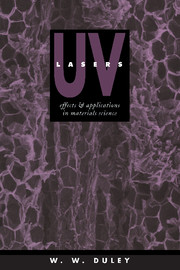Book contents
- Frontmatter
- Contents
- Preface
- Acknowledgments
- 1 Short wavelength lasers
- 2 Optical properties of materials at UV wavelengths
- 3 Photochemical and photothermal effects
- 4 Interaction of UV laser radiation with metals
- 5 Interaction of UV radiation with organic polymers
- 6 Interactions and material removal in inorganic insulators
- 7 UV laser preparation and etching of superconductors
- 8 Interactions and effects in semiconductors
- 9 Laser deposition
- Index
7 - UV laser preparation and etching of superconductors
Published online by Cambridge University Press: 16 November 2009
- Frontmatter
- Contents
- Preface
- Acknowledgments
- 1 Short wavelength lasers
- 2 Optical properties of materials at UV wavelengths
- 3 Photochemical and photothermal effects
- 4 Interaction of UV laser radiation with metals
- 5 Interaction of UV radiation with organic polymers
- 6 Interactions and material removal in inorganic insulators
- 7 UV laser preparation and etching of superconductors
- 8 Interactions and effects in semiconductors
- 9 Laser deposition
- Index
Summary
INTRODUCTION
Shortly after the announcement of high temperature superconductivity in the La–Ba–Cu–O (Bednorz and Müller 1986) and Y–Ba–Cu–O (Wu et al. 1987a) systems the first reports were published describing in situ preparation of superconducting thin films using laser ablation (Dijkkamp et al. 1987, Wu et al. 1987b, Narayan et al. 1987). The laser ablation method, which is a well known technique for the preparation of thin films of a variety of materials (Duley 1983, Bäuerle 1986, Braren et al. 1993, Chrisey and Hubler 1994), was found to be well suited to the deposition of superconducting films since it permits flexible control over deposition conditions and yields films with good stoichiometry.
Materials such as Y–Ba–Cu–O are, however, complex from both a chemical and a structural point of view (Burns 1992) and therefore vaporization and redeposition of these materials using laser radiation is anticipated to be a complicated process. A full understanding of the physical and chemical mechanisms that accompany laser ablation and in situ deposition has yet to be obtained. Nevertheless, useful progress has been made in the preparation of superconducting films with high zero resistance temperatures (about 90 K) and critical current densities exceeding 106 A cm–2 using the laser ablation method.
DEPOSITION AND PROPERTIES
The use of excimer laser radiation to prepare thin films of superconducting material by laser vaporization of the parent compound was first reported in 1987 (Dijkkamp et al. 1987, Wu et al. 1987b, Narayan et al. 1987).
- Type
- Chapter
- Information
- UV LasersEffects and Applications in Materials Science, pp. 276 - 307Publisher: Cambridge University PressPrint publication year: 1996



